Collins Aerospace, a Raytheon Technologies subsidiary, is one of the world's largest suppliers of aerospace and defense products, headquartered in Charlotte, North Carolina.
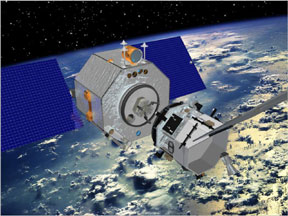
Orbital Express was a space mission managed by the United States Defense Advanced Research Projects Agency (DARPA) and a team led by engineers at NASA's Marshall Space Flight Center (MSFC). The Orbital Express program was aimed at developing "a safe and cost-effective approach to autonomously service satellites in orbit". The system consisted of two spacecraft: the ASTRO servicing satellite, and a prototype modular next-generation serviceable satellite; NEXTSat. The mission launched from Cape Canaveral Air Force Station on 8 March 2007, aboard an Atlas V expendable launch vehicle. The launch was part of the United States Air Force Space Test Program STP-1 mission.

TacSat-2 was an experimental satellite built by the USAF's Air Force Research Laboratory with an operational life expected to be not more than one year as part of the 'Advanced Concept Technology Demonstration' program.
The Space Test Program (STP) is the primary provider of spaceflight for the United States Department of Defense (DoD) space science and technology community. STP is managed by a group within the Advanced Systems and Development Directorate, a directorate of the Space and Missile Systems Center of the United States Space Force. But STP is a DoD-wide organization. STP provides spaceflight via the International Space Station, piggybacks, secondary payloads and dedicated launch services.
The Multi-Application Survivable Tether (MAST) experiment was an in-space investigation designed to use CubeSat spacecraft connected by tethers to better understand the survivability of tethers in space. It was launched as a secondary payload on a Dnepr rocket on 17 April 2007 into a 98°, 647 x 782 km orbit. The MAST payload incorporated three picosatellites, named "Ralph," "Ted," and "Gadget," which were intended to separate and deploy a 1 km (0.62 mi) tether. The experiment hardware was designed under a NASA Small Business Technology Transfer (STTR) collaboration between Tethers Unlimited, Inc. (TUI) and Stanford University, with TUI developing the tether, tether deployer, tether inspection subsystem, satellite avionics, and software, and Stanford students developing the satellite structures and assisting with the avionics design.
The United States Naval Academy (USNA) Small Satellite Program (SSP) was founded in 1999 to actively pursue flight opportunities for miniature satellites designed, constructed, tested, and commanded or controlled by Midshipmen. The Naval Academy's aerospace laboratory facilities are some of the most advanced and extensive in the country. These facilities include structures labs, propulsion and rotor labs, simulation labs, wind tunnels with flow velocities ranging from subsonic to supersonic, computer labs, and the Satellite Ground Station. The SSP provides funds for component purchase and construction, travel in support of testing and integration, coordination with The US Department of Defense or National Aeronautics and Space Administration (NASA) laboratories or with universities for collaborative projects, and guides Midshipmen through the Department of Defense (DoD) Space Experiments Review Board (SERB) flight selection process.
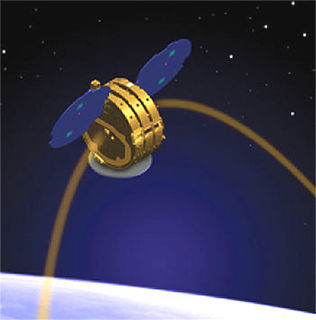
TacSat-1 was an experimental satellite built by the Naval Research Laboratory on behalf of the United States Department of Defense (DOD) Office of Force Transformation (OFT). It was the planned payload of the sixth launch of the SpaceX Falcon 1. It was however never launched into space. The second satellite in the series, TacSat-2, launched before TacSat-1 and this led to the cancellation of TacSat-1's launch.

TacSat-3 was the third in a series of U.S. military reconnaissance satellites. It was assembled in an Air Force Research Laboratory Space Vehicles Directorate facility at Kirtland Air Force Base, New Mexico. The TacSat satellites are all designed to demonstrate the ability to provide real-time data collected from space to combatant commanders in the field. TacSat-3 includes three distinct payloads: the Advanced Responsive Tactically Effective Military Imaging Spectrometer (ARTEMIS) hyperspectral imager, the Ocean Data Telemetry Microsatellite Link and the Space Avionics Experiment.
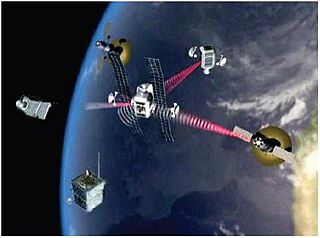
A fractionated spacecraft is a satellite architecture where the functional capabilities of a conventional monolithic spacecraft are distributed across multiple modules which interact through wireless links. Unlike other aggregations of spacecraft, such as constellations and clusters, the modules of a fractionated spacecraft are largely heterogeneous and perform distinct functions corresponding, for instance, to the various subsystem elements of a traditional satellite.
The Near Earth Object Surveillance Satellite (NEOSSat) is a Canadian microsatellite using a 15-cm aperture f/5.88 Maksutov telescope, with 3-axis stabilisation giving a pointing stability of ~2 arcseconds in a ~100 second exposure. It is funded by the Canadian Space Agency (CSA) and Defence Research and Development Canada (DRDC), and searches for interior-to-Earth-orbit (IEO) asteroids, at between 45 and 55 degree solar elongation and +40 to -40 degrees ecliptic latitude.
TacSat-5 is a planned fifth satellite in a series of U.S. military reconnaissance satellites. The project will be managed by the Air Force Research Laboratory in cooperation with the Operationally Responsive Space Office of the Department of Defense. The TacSat satellites are all designed to demonstrate the ability to provide real-time data collected from space to combatant commanders in the field.
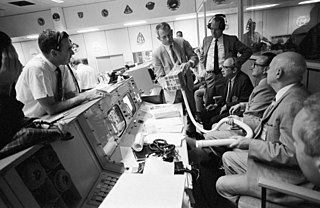
Aerospace engineering is the primary field of engineering concerned with the development of aircraft and spacecraft. It has two major and overlapping branches: aeronautical engineering and astronautical engineering. Avionics engineering is similar, but deals with the electronics side of aerospace engineering.

A number of space tethers have been deployed in space missions. Tether satellites can be used for various purposes including research into tether propulsion, tidal stabilisation and orbital plasma dynamics.

USA-231, or ORS-1 is an American reconnaissance satellite which was launched in 2011 from NASA’s Wallops Flight Facility, Virginia by a Minotaur I launch vehicle. It is the first operational satellite of the Operationally Responsive Space Office. It is equipped with a SYERS 2A sensor.
The Global Educational Network for Satellite Operations (GENSO) is forming by a worldwide network of ground stations and spacecraft which can interact via a software standard. The GENSO aims to increase the return from educational space missions and changed the way that these missions are managed, dramatically increasing the level of access to orbital educational spacecraft.
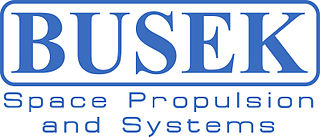
Busek Co. Inc. is a spacecraft propulsion company providing thrusters, electronics, and complete systems for spacecraft.

PhoneSat is an ongoing NASA project of building nanosatellites using unmodified consumer-grade off-the-shelf smartphones and Arduino platform and launching them into Low Earth Orbit. This project is part of NASA's Small Spacecraft Technology Program and was started in 2009 at NASA Ames Research Center.
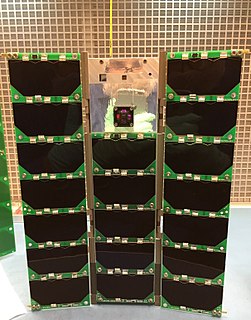
The Miniature X-ray Solar Spectrometer (MinXSS) CubeSat was the first launched National Aeronautics and Space Administration Science Mission Directorate CubeSat with a science mission. It was designed, built, and operated primarily by students at the University of Colorado Boulder with professional mentorship and involvement from professors, scientists, and engineers in the Aerospace Engineering Sciences department and the Laboratory for Atmospheric and Space Physics, as well as Southwest Research Institute, NASA Goddard Space Flight Center, and the National Center for Atmospheric Research's High Altitude Observatory. The mission principal investigator is Dr. Thomas N. Woods and co-investigators are Dr. Amir Caspi, Dr. Phil Chamberlin, Dr. Andrew Jones, Rick Kohnert, Professor Xinlin Li, Professor Scott Palo, and Dr. Stanley Solomon. The student lead was Dr. James Paul Mason, who has since become a Co-I for the second flight model of MinXSS.
The Tera-hertz Explorer (TEREX) mission is a planned orbiter and lander that will be carrying a terahertz sensor to the surface of Mars to measure the oxygen isotope ratios of various molecules in the Martian atmosphere. The objective of the mission is to understand the chain of chemical reactions that resupply the atmosphere with carbon dioxide.











